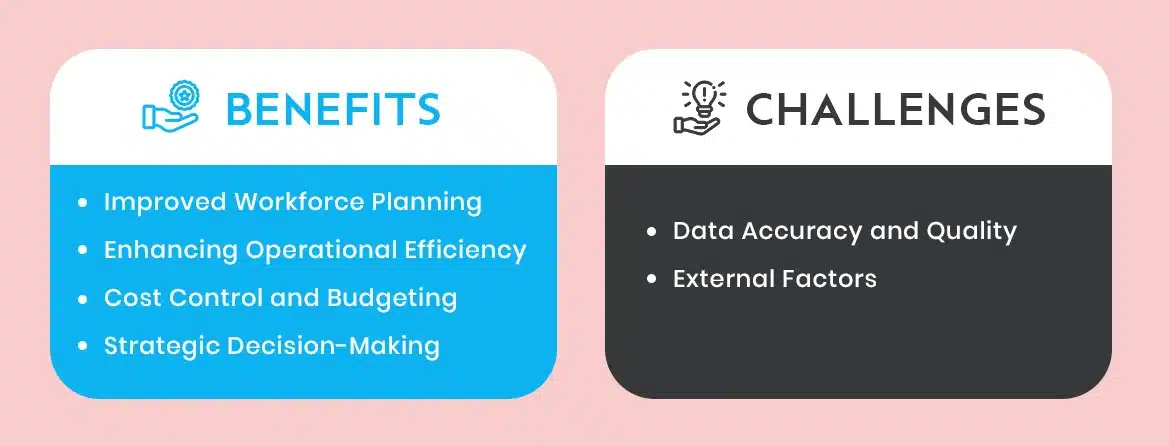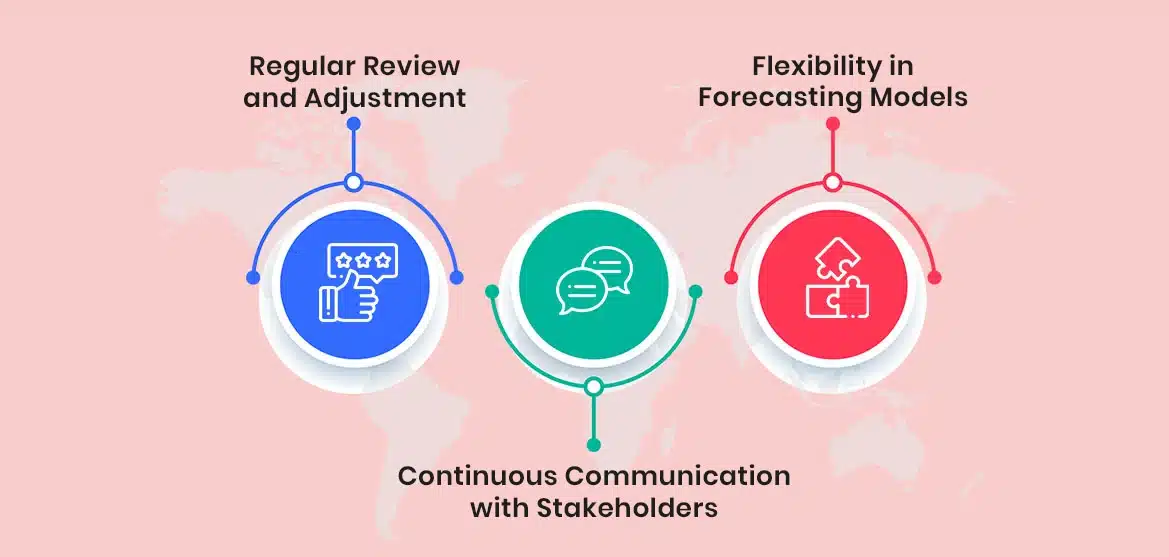Table of content
In the dynamic realm of HR tech, headcount forecasting plays a pivotal role. It goes beyond mere numbers, delving into the intricacies of aligning personnel resources with the ever-evolving goals of a company. Understanding the significance of this forecasting goes hand in hand with efficient workforce planning.
In this blog, we will embark on demystifying the concept, emphasizing its relevance in the HR tech landscape, where adaptability and precision in planning are the keys to success.
Benefits of Headcount Forecasting
Headcount forecasting is a crucial tool for organizations to anticipate and address future workforce needs, align their human resources with strategic objectives, and foster a more agile and resilient organization. This practice offers several benefits for businesses:
Improved Workforce Planning
In the realm of HR tech, effective workforce planning is a game-changer. Headcount forecasting allows organizations to recruit strategically with precise business goals. This means having the right people in the right roles at the right time. By understanding future workforce needs, companies can proactively address skill gaps and ensure a more agile and responsive workforce.
Enhancing Operational Efficiency
Operational efficiency is the heartbeat of any successful organization. Headcount forecasting plays a crucial role in enhancing this efficiency by ensuring that teams are appropriately staffed. This not only prevents overstaffing, which can strain budgets, but also guards against understaffing, which could compromise productivity and quality of work. The result is a well-balanced and finely tuned operational environment.
Cost Control and Budgeting
Avoiding the extremes of overstaffing and understaffing directly contributes to effective cost control and budgeting. Headcount forecasting provides the insights needed to optimize resource allocation, aligning workforce expenditure with business needs. This strategic approach helps organizations operate within budgetary constraints while maintaining a workforce that can meet the demands of the business.
Strategic Decision-Making
Identifying Skill Gaps is a strategic insight offered by headcount forecasting. By recognizing gaps in the current skill set, HR teams can take a proactive approach to training and development. Moreover, adapting to market trends becomes more feasible when armed with a clear understanding of the workforce’s strengths and weaknesses. This strategic foresight positions organizations to make informed decisions, ensuring they stay ahead in a competitive landscape. In the fast-paced world of HR tech, these benefits underscore the significance of headcount forecasting as a cornerstone of strategic planning and decision-making.
Challenges in Headcount Forecasting
While headcount forecasting offers numerous benefits, it also comes with its own set of challenges. Some common challenges include:
Data Accuracy and Quality
The bedrock of effective headcount forecasting lies in the accuracy and quality of data. Reliable forecasts depend on precise inputs, ranging from turnover rates to performance metrics. Common challenges emerge from inconsistent data entry and outdated information. Addressing these issues demands a commitment to meticulous data management, emphasizing accuracy and regular updates.
External Factors
Headcount forecasting doesn’t operate in isolation; external factors add a layer of complexity. Economic conditions wield influence, with downturns and upswings requiring agile adjustments. Industry changes, from technological shifts to regulatory updates, further impact workforce dynamics. Navigating these external factors demands a dynamic forecasting model that can adapt to the evolving landscape. Acknowledging the dual challenges of data intricacies and external uncertainties is pivotal, guiding organizations to build resilient headcount forecasting strategies that stand the test of time.
How to Forecast Headcount
Forecasting headcount involves predicting the number of employees needed in the future based on various factors such as business growth, market demand, and internal changes. By combining quantitative analysis with qualitative insights, organizations can develop robust headcount forecasts that support strategic goals and enhance overall workforce planning. Here are the steps to effectively forecast headcount:
Data Collection and Analysis
Effective headcount forecasting begins with meticulous data collection and analysis. Historical data, including employee turnover rates and past workforce trends, provides valuable insights. Simultaneously, monitoring market trends is crucial. Understanding the external landscape ensures that forecasts align with broader industry dynamics, preparing organizations for future challenges.
Collaboration between HR and Departmental Managers
A collaborative approach between HR and departmental managers is pivotal in accurate headcount forecasting. HR teams need to delve into the specifics of each department, understanding their unique needs and challenges. This collaboration ensures that headcount forecasts are not only based on overall organizational goals but also tailored to the intricacies of each department. Aligning HR strategies with business objectives becomes a shared responsibility, fostering a more holistic and effective approach to workforce planning.
Technology and Tools in Headcount Forecasting
In the digital age, leveraging HR tech solutions is paramount. There are multiple tools that offer advanced analytics and forecasting capabilities. Integration with existing systems streamlines the process, ensuring a seamless flow of data. The adoption of technology not only enhances the accuracy of forecasts but also improves the efficiency of the entire forecasting process. By embracing a combination of human insights and technological advancements, organizations can navigate the complexities of forecasting headcounts with precision and foresight.
Best Practices in Headcount Forecasting
Effective headcount forecasting involves a combination of data-driven methodologies, collaboration across departments, and adaptability to changing business conditions. Here are some best practices to enhance the accuracy and reliability of headcount forecasting:
Regular Review and Adjustment
Headcount forecasting is not a one-and-done task; it’s an ongoing process. Regularly reviewing and adjusting forecasts ensures they remain aligned with the ever-evolving business landscape. Whether prompted by internal changes or external factors, this practice allows organizations to stay agile and responsive to emerging trends.
Continuous Communication with Stakeholders
Effective communication is the glue that holds successful headcount forecasting together. Maintaining an open line with departmental managers, leadership, and other stakeholders ensures that forecasts are grounded in real-time insights. This collaborative approach not only enhances the accuracy of forecasts but also fosters a shared understanding of workforce needs and challenges.
Flexibility in Forecasting Models
Rigid forecasting models can quickly become obsolete. Building flexibility into forecasting models allows organizations to adapt to unexpected changes. Whether it’s a sudden market shift or internal restructuring, a flexible approach ensures that headcount forecasts remain relevant and resilient in the face of uncertainty. Embracing these best practices transforms headcount forecasting from a static task into a dynamic tool for strategic workforce planning.
Conclusion
In our journey through headcount forecasting, we’ve learnt its strategic significance in shaping a resilient workforce. From aligning resources with business goals to overcoming challenges, each step contributes to a holistic approach.
Headcount forecasting isn’t just a task; it’s a linchpin in HR strategy. It empowers organizations to proactively address challenges, optimize costs, and make informed decisions. As the bridge between past experiences and future possibilities, headcount forecasting stands as a crucial pillar in building a workforce prepared for the challenges of tomorrow.



